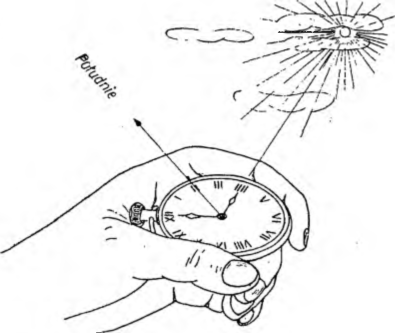 Za pomocą kieszonkowego zegarka można określić w słoneczny dzień z dostateczną dla praktycznych celów dokładnością cztery strony świata na widnokręgu, tj. kierunek północy, południa, wschodu i zachodu. Sposób ten jest tak prosty i łatwo zrozumiały, że należy się dziwić, iż dotychczas nie znalazł powszechnego zastosowania.
Za pomocą kieszonkowego zegarka można określić w słoneczny dzień z dostateczną dla praktycznych celów dokładnością cztery strony świata na widnokręgu, tj. kierunek północy, południa, wschodu i zachodu. Sposób ten jest tak prosty i łatwo zrozumiały, że należy się dziwić, iż dotychczas nie znalazł powszechnego zastosowania.
Określenie kierunku polega na następującej manipulacji:
Trzymając w ręku kieszonkowy zegarek należy go obrócić w ten sposób, żeby wskazówka godzinowa była skierowana w stronę Słońca; wówczas kropka leżąca na obwodzie koła pośrodku między wskazówką godzinową a liczbą XII ustali nam kierunek południa.
Więc na przykład, jeśli wskazówka godzinowa wskazuje godzinę IV (jak na naszym rysunku), to skierowawszy wskazówkę tę ku Słońcu stwierdzimy, że środkowa kropka między wskazaną godziną IV a liczbą XII, czyli kropka oznaczająca godzinę II, określi kierunek południa. W przeciwnym kierunku będzie północ, na lewo — wschód, na prawo — zachód.
Poprzednią regułę można zmodyfikować w sposób następujący: należy znaleźć na obwodzie tarczy punkt środkowy między godziną, którą pokazuje mała (godzinowa) wskazówka, i kropką nad liczbą XII — i skierować tę środkową kropkę ku Słońcu; wówczas godzina XII wskaże kierunek południa.
Na przykład, jeśli zegarek wskazuje godzinę IV, to należy skierować ku Słońcu podziałkę znajdującą się nad godziną II. Wówczas linia przeprowadzona od środka zegarka ku liczbie XII będzie wskazywała kierunek południa.
Dla potwierdzenia powyższego wystarczy przypomnieć, że o godzinie XII w południe Słońce, wskazówka godzinowa i podziałka ponad liczbą XII leżą w jednej linii skierowanej na południe. Następnie i Słońce, i godzinowa wskazówka posuwają się w tym samym kierunku, lecz wskazówka godzinowa dokona pełnego obrotu w 12 godzin, a Słońce w 24 godziny, to jest w dwa razy dłuższym okresie czasu. Na tym właśnie opierają się powyższe reguły.
Należy dodać, że przed południem szukać trzeba punktu średniego pomiędzy wskazówką i godziną XII w kierunku obrotu wskazówek, po południu zaś — w kierunku przeciwnym.
Uwaga. Oczywiście znaleziony tym sposobem kierunek nie będzie dokładny. Wadliwość spowodowana jest tym, że umieszczamy zegarek w płaszczyźnie poziomej zamiast w płaszczyźnie równika niebieskiego. Nie bierze się przy tym pod uwagę różnicy między prawdziwym czasem słonecznym a czasem ustawowym, według którego idą zegary (u nas jest to czas środkowo-europejski). Lecz dla celów praktycznych wskazane wyżej prawidło daje zupełnie zadowalające rezultaty.
Jeśli Czytelnik tej książki znajduje się na południowej półkuli, to podane prawidła trzeba zmienić jak następuje:
Gdy punkt oznaczony na tarczy zegarka nad wskazówką godzinową skierujemy ku Słońcu, wtedy linia przepoławiająca kąt między wskazówką godzinową a kropką nad liczbą XII zaznaczy kierunek północy.